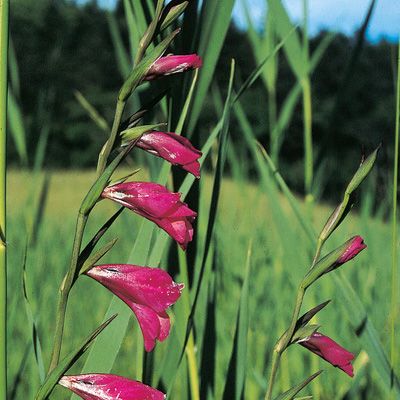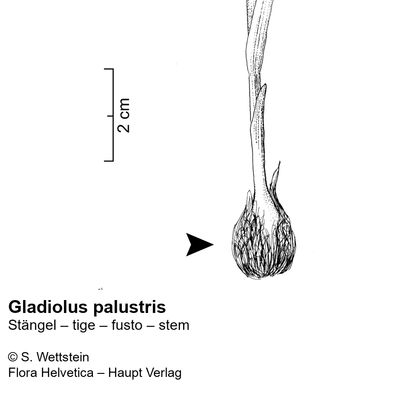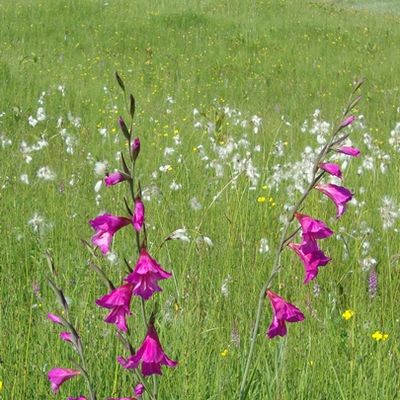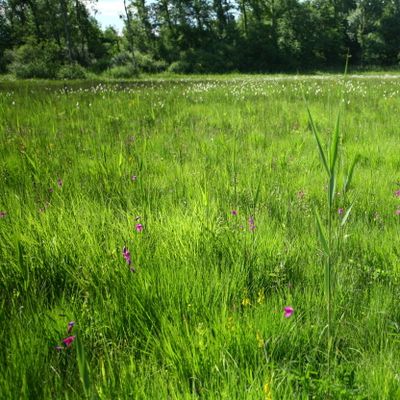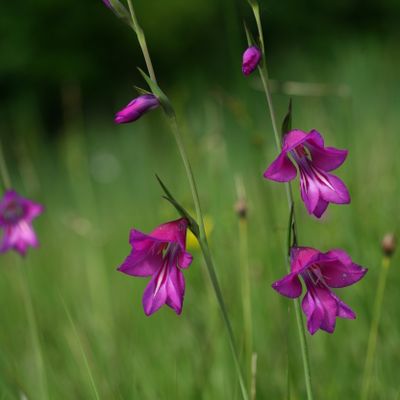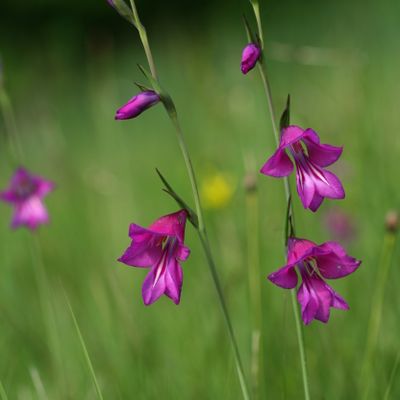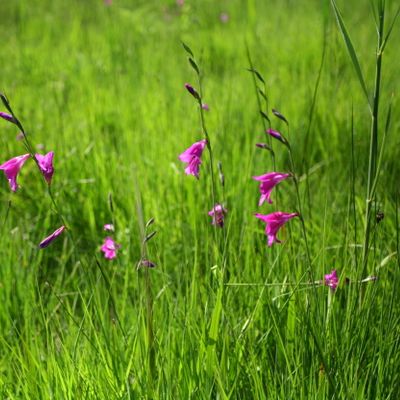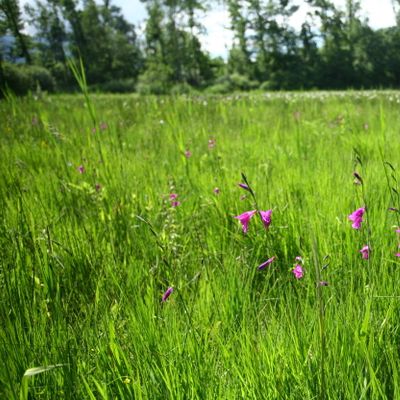Gladiolus palustris Gaudin
1021650
Species
ISFS : 190100
Checklist : 1021650
ISFS : 190100
Checklist : 1021650
Contains :
Synthesis
Species description (© Flora Helvetica 2018)
30-50 cm hoch, Fasern der Knollenhülle ein Netz mit rundlichen oder vieleckigen Maschen bildend. Stängel beblättert. Blätter lineal-lanzettlich, meist nur 0,5-1 cm breit. Blütenstand eine 3-8blütige, einseitswendige Ähre, jede Blüte mit einem Vorblatt. Perigonblätter 6, karminrot, bis 3 cm lang, am Grund kurz verwachsen, Zipfel einen gebogenen Trichter bildend, die oberen grösser und aufrecht, die unteren bedeutend schmäler und oft abstehend. Frucht eine 3fächerige, vielsamige Kapsel.Flowering period (© Flora Helvetica 2018)
6-7Habitat and distribution inside Switzerland (© Flora Helvetica 2018)
Feuchte Wiesen, selten auch auf trockenen Böden / kollin-montan / GE, VS (unteres Rhonetal), GR (Rheintal), SG, TG, ZH, ZG, LU, südliches TIWorld distribution (© Flora Helvetica 2018)
Mittel- und südosteuropäischEcological indicator (© Landolt & al. 2010)
4w+43-43+3.g.2n=60Status
IUCN status
EndangeredNational Priority
3 - medium national priorityInternational responsibility
1 - weakConservation
Threats
Meliorationen, Entwässerungen
Bewirtschaftungsänderungen, Aufgabe der Streuenutzung, Verbuschung, Verschilfung
Zu frühe Mahd
(Ersatz-)Aufforstungen, «Pappelplantagen»
Eutrophierung
Sammlen, Ausgraben
Unsachkundige Ansiedlungen (z. B. fremdes Material)
Wenige, isolierte Populationen
Distribution map
Habitat and distribution inside Switzerland
GE, VS (unteres Rhonetal), GR (Rheintal), SG, TG, ZH, ZG, LU, südliches TIWorld distribution
Mittel- und südosteuropäischEcology
Life form
Geophyte
Habitats
Milieux Phytosuisse (© Prunier et al. 2017)
Habitats © Delarze & al. 2015
 | 2.3.1 - Pfeifengraswiese (Molinion) |
bold
Dominant species, influencing the appearance of the habitat
 Character species
Character species
 Less strictly linked to a specific habitat
Less strictly linked to a specific habitat
Ecological indicator values by © Landolt & al. (2010)
| Soil factors | Climatic factors | Salinity tolerance | |||
|---|---|---|---|---|---|
| Humidity Value H | 4w+ | Light Value L | 4 | Salinity Index | -- |
| Reaction Value R | 4 | Temperature factor T | 3+ | ||
| Nutriments value N | 3 | Continentality K | 3 | ||
- Ecological values legend
Humidity Value H 1 very dry 1+ dry 2 moderatly dry 2+ moist 3 medium wet 3+ wet 4 very wet 4+ soggy 5 submerged or underwater f plants living in running water u mostly submerged plants v partly submerged, partly floating plants w humidity moderately variable (± scale of 1-2) w+ highly variable humidity (scale exceeding ± 2) Reaction Value R 1 Very acid (pH 2.5-5.5) 2 acid (pH 3.5-6.5) 3 lightly acid to neutral (pH 4.5-7.5) 4 neutral to basic (pH 5.5-8.5) 5 basic (pH 6-5 -> 8.5 Nutriments value N 1 very low in nutrients 2 low in nutriments 3 medium-poor to medium-rich in nutrients 4 rich in nutriments 5 very rich in nutriments Salinity tolerance 1 halotolerant 3 halophyle Light Value L 1 very shady 2 shady 3 lighted areas 4 luminous 5 highly luminous Temperature factor T 1 alpine to nival stages (from the treeline to the snowline) 1+ suprasubalpine and upper subalpine levels (pine and larch forests) 2 subalpine level (coniferous forests without beeches up to the upper limit of spruces) 2+ lower subalpine and upper mountain stages 3 mountain level (beech and silver fir forests, in the central Alps Scots pine forests) 3+ lower mountain and upper hill levels 4 hill level (mixed deciduous oak forests) 4+ hot places, hill level 5 very hot places, hill level (only in the hottest places, typical of southern Europe) Continentality K 1 Atlantic (high air humidity, very low temperature variations, mild winters) 2 Sub-Atlantic (high air humidity, low temperature variations, relatively mild winters) 3 sub-Atlantic to subcontinental (average air humidity, moderately variable temperature, slightly low winter temperatures) 4 subcontinental (low air humidity, large temperature variations, rather cold winters) 5 continental (very low air humidity, very large temperature variations, cold winters)
Water dependency
| Rivers | 1 - Secondary habitat |
| Calm water | 1 - Secondary habitat |
| Ground water | 0 - No link |
Nomenclature
Accepted Name (Checklist 2017)
Gladiolus palustris Gaudin
Vernacular name
Deutscher Name :
Sumpf-Gladiole, Sumpf-SiegwurzNom français :
Glaïeul des maraisNome italiano :
Gladiolo reticulatoMatch with other reference books
| Relation | Nom | Book | No |
|---|---|---|---|
| = | Gladiolus palustris Gaudin | Checklist 2017 | 190100 |
| = | Gladiolus palustris Gaudin | Flora Helvetica 2001 | 2918 |
| = | Gladiolus palustris Gaudin | Flora Helvetica 2012 | 2502 |
| = | Gladiolus palustris Gaudin | Flora Helvetica 2018 | 2502 |
| = | Gladiolus palustris Gaudin | Index synonymique 1996 | 190100 |
| = | Gladiolus palustris Gaudin | Landolt 1977 | 715 |
| = | Gladiolus palustris Gaudin | Landolt 1991 | 622 |
| = | Gladiolus palustris Gaudin | SISF/ISFS 2 | 190100 |
| = | Gladiolus palustris Gaudin | Welten & Sutter 1982 | 2132 |
= The taxon corresponds to the accepted taxon (Checklist 2017)
< The taxon is included in the accepted taxon (Checklist 2017)
> The taxon includes (among others) also the accepted taxon (Checklist 2017)
< The taxon is included in the accepted taxon (Checklist 2017)
> The taxon includes (among others) also the accepted taxon (Checklist 2017)
Status
Native status
-IUCN list of endangered species (© Walter & Gillett 1997) : Yes
Status on national Red List 2016
IUCN status:
Endangered

Additional information
IUCN criteria: A4cd; C2a(ii)
Status on regional Red List 2019
| Biogregraphic regions | Status | IUCN criteria |
|---|---|---|
| Jura (JU) | -- | |
| Mittelland (MP) | EN | A4cd; C2a(ii) |
| Alpennordflanke (NA) | CR | A4cd; C2a(ii) |
| Alpensüdflanke (SA) | CR | C1 |
| Östliche Zentralalpen (EA) | CR(PE) | |
| Westliche Zentralalpen (WA) | RE |
- Legend
EX Extinct RE Regionally Extinct CR(PE) Critically Endangered, Probably Extinct CR Critically Endangered EN Endangered VU Vulnerable NT Near Threatened LC Least Concern DD Data Deficient NE Not Evaluated NA Not Applicable
National Priority Species List Status
| National Priority | 3 - medium national priority |
| Need to take action | 2 - |
| International responsibility | 1 - weak |
| Need to monitor populations | 2 - |
Protection status
| International (Bern Convention) | No | |
| GE | total protection | (25.07.2007) |
| GR | total protection | (01.12.2012) |
| VD | total protection | (02.03.2005) |
| Switzerland | total protection | |
| ZG | total protection | (01.10.2013) |
| TI | total protection | (23.01.2013) |
- Disclaimer
InfoFlora compiles information on protected species as accurately as possible, taking it from the respective cantonal laws. In some cases, however, it was not possible to use the plant names as listed in the original text, but an interpretation of their taxonomy or nomenclature was necessary. The exact meaning of the categories „completely protected“ and „partially protected“ differs among the cantons.
InfoFlora cannot guarantee that the information on the protection status is correct and complete. In case of doubts, we recommend to look up the texts of the respective cantonal law.
Status by sector of activity
| Agriculture-related environmental objectives : | Z - | more informations |
| Forest management environmental objectives : | more informations |
Conservation
Threats and measures
Meliorationen, Entwässerungen
Schutz aller noch bestehenden Feuchtgebiete
Aufrechterhaltung eines für die Art günstigen Wasserhaushalts (u. a. durch Regulierung der bestehenden alten Drainagegräben)
evtl. lokal vernässen
Bewirtschaftungsänderungen, Aufgabe der Streuenutzung, Verbuschung, Verschilfung
Beibehaltung der traditionellen Streunutzung (Ökobeiträge), falls notwendig entbuschen
Zu frühe Mahd
Bestände möglichst spät, erst ab Oktober oder besser erst im Winter alle 1-2 Jahre mähen
(Ersatz-)Aufforstungen, «Pappelplantagen»
Keine Aufforstungen in Feuchtgebieten
Eutrophierung
Grosse Pufferzonen ohne Düngung
Sammlen, Ausgraben
Informationstafeln zu Sammelverbot
an einigen Fundstellen Betretverbote
Unsachkundige Ansiedlungen (z. B. fremdes Material)
Wiederansiedlungen höchstens nach sorfältiger Planung und Bedarfsabklärung durchführen, wissenschaftlich begleiten
Erfolgskontrollen gewährleisten
Wenige, isolierte Populationen
Schutz (Mikroreservate) und regelmässige Bestandskontrollen, Dauerflächen-Beobachtung
Detailkartierung der Fundstellen
Erfolgskontrolle der Massnahmen gewährleisten. Verstärkung bestehender Populationen und Ansiedlung neuer Populationen durch Anpflanzung/Ansaat (nach Zwischenvermehrung)
